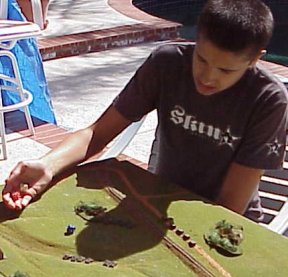|
Combat - Boot Camp |
||

|
In order to have combat a tank must 'attack' or shoot an enemy vehicle. If there is a direct line of sight it can fire its weapons at the enemy tank. Besides a line of sight the distance |
||
|
1. First measure the range to the target vehicle. Measure from the turret (or roof edge) of the shooting vehicle to turret edge of the enemy vehicle. Measure the distance in millimeters. |
||

|
After consulting the table for the required to-hit number roll a single D10 for each shooting tank. If the required number is made then a hit is scored on the |
||

|
The above is part of the German 75mm/70 gun table, the gun on the Panther tank. The row titled 'To Hit' lists the numbers needed to score a hit. The first number and biggest number is the base to-hit number. The smaller numbers separated by dots are the number needed for two or three hits. Looking at the column listed 3.7.11 with 550 listed under it in the 'Range' row. This means if a 3 was need for one hit, then a '7' is needed to get two hits and '11' is needed |
||
|
during the turn there is a +3 added to the score. All these circumstances must be taken into account and the added numbers totaled to sum. This sum then becomes the to-hit number. The Direct Fire To Hit Modifiers table lists all the circumstances and the number that must be added because of each. |
||
|
If a hit is scored on the enemy tank a D10 is rolled by the shooting player on the whereabouts on the vehicle the shot lands. The higher numbers tend to be the upper part of the tank while the smaller numbers the lower parts of the tank. Each armored vehicle will have its own tank data table. Listed would be its armor on the front, side and rear at 10 main locations. Also a listing of the armor on the top turret and top hull (over the engine). Even cupola armor (if any) is listed. |
||

|
Tank table for a Sherman M4 'Easy 8'. Location 6 on the front has 9 underline armor. The underline means it is highly sloped |
||
|
to make first. This is a variable penetration roll. You see tanks aren't always parked at right angles to the shooting tanks. They could be turning and at different angles from second to second. They aren't always on an absolutely flat parking lot. They may be on sloped ground or going over undulating ground and are at a different tilt second to second. Also, shells don't always penetrate the same amount. So to take in all the possible factors that could degrade the shell penetration we roll a D6 and modify the listed or maximum penetration. |
||